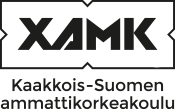Presentation skills (5 cr)
Code: GD00CU00-3009
General information
Enrollment
08.11.2021 - 21.11.2021
Timing
01.01.2022 - 01.05.2022
Number of ECTS credits allocated
5 op
Virtual portion
2 op
RDI portion
1 op
Mode of delivery
60 % Contact teaching, 40 % Distance learning
Campus
Kouvola Campus
Teaching languages
- English
Seats
10 - 25
Degree programmes
- Degree Programme in Game Design
Teachers
- Sarah-Jane Leavey
- Panu Vuoristo
Teacher in charge
Sarah-Jane Leavey
Groups
-
GDKV21SPGame design, full-time studies
Objective
You know the basics of the axonometric and descriptive geometry and the drawing of one vanishing point from three different projections of the perspective picture.
You can draw a circle, ellipse and free curves in perspective by free hand.
You master proportions in the perspective picture.
You can use line thickness as an effect.
You can use presentation technical methods to create credible presentation pictures by free hand.
You can combine pictures and text in a presentation poster.
You know the basics of using shades and shadings in perspective picture.
You can draw and stylize a person (a woman, man, child) anatomically right.
You know how to present outfits and materials over a human model in different positions and how to realistically execute the materials of surfaces, forms and spaces
You master the use of colour pencils, felt-tip pens and dry pastels.
Content
How to implement the European first angle projection?
How to mark the dimensioning in accordance with the standards?
How to draw a perspective picture?
How to visualise an idea by drawing?
How to create coloured inner and/or outer views?
How to present a small object as an axonometric presentation picture and as projections?
How to create a presentation poster?
How to present coloured presentation pictures of clothing on a person or different materials and surface forms with different tools?
Materials
Learning materials
– Lectures and demonstrations with accompanying downloadable documentation for reference.
– Downloadable Work sheets and exercises
– Links and tutorials on Learn.
Teaching methods
Learning route based on a working week
You will attend teaching and guidance sessions as specified in the schedule. Your study routine is determined by the scheduled group sessions and by the self-study assignments.
Learning route that accelerates the studies
If you have acquired prior learning in the subject (fully/partially), contact the teacher in charge prior the course to discuss whether you have the competence required and what are the methods of demonstrating that competence. If you are unable to attend all the classes due to other courses, you are required to complete the learning assignments independently.
Work-based learning route
You need to contact the course teacher prior the course to agree on development assignments that you will perform at your work place. You are required to prove your learning both in theory and practice by giving a presentation at Game Design show and tell day.
Employer connections
RDI will be intergrated where possible
Exam schedules
Deadlines:
– In order to benefit from the dedicated feedback sessions students must have at least partially completed the assignments on review at that time.
– If a student misses the deadline for an assignment feedback session, no assurance of feedback at a later date can be given. Current works take precedence.
– If a student can not achieve a required deadline the lecturer must be informed and an extension will be negotiated.
– Unauthorised late return of course assignments will have an effect on final grading. (Between 1 and 2 points deducted)
Student workload
In class, student will complete instructive exercises and then receive feedback to deepen their expertise.
Students will also complete assignments independently or in groups outside of class.
Content scheduling
The student will create a series of drawing demonstrating the following skills
Elements include:
One point Perspective
Two point perspective
Use of Line thicknesses to define spacial relationships
Mirroring techniques
Transfering points
Basic anatomy block out and the human skeleton
Further information
Further information
– Demonstrations and lectures (maybe streamed via Teams) provide relevant theoretical content.
– Students complete a series of colour based assignments independently with the help of instructions provided on Learn.
– Students will receive dedicated feedback sessions on their assignments at regular intervals
– Students will deepen their expertise in the use of colour within the perspective of game design.
Evaluation scale
1-5
Assessment methods and criteria
Assessment Methods:
Collaborative Learning outcomes (Group works)
Peer review and self-evaluation
Register of Attendance
Adherence to schedules and deadlines
Activity Checklists
Performance Rating scale for classroom and homework assignments
Assessment Criteria
Students ability to develop ideas, logical thinking, creativity, ability to communicate one’s ideas both verbally and visually, quality of work, ability to follow instructions, ability to work to deadlines, level of attendance, activity and contribution to class, evidence of improvement in technical/design/aesthetic skills.
Grading. Fail, Incomplete, 1:pass, 2:pass+ 3:Commended 4:Highly commended 5:Distinction
Assessment scale 1-5
